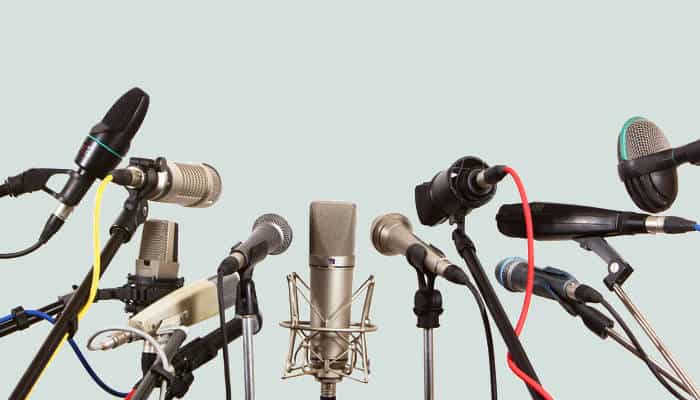How to Choose a Vocal Mic for Live Performances

by Justin Leighton Long
For a bunch of reasons, it’s really nice to have your own mic for live performances.
From questions I get asked, it seems like one big reason that a lot of singers don’t have their own mic is simply being confused by all the choices.
Well don’t worry, we’ll cover some microphone basics that will help you find the right mic for your voice, and even make some solid product recommendations.
Two Types of Mics
Live microphones come in two types: condenser and dynamic.
What’s the difference? Let’s keep it simple and focus on this one idea:
Condenser mics are more sensitive and reveal more detail of the voice, while dynamics are sturdier and easier to use.
On the face of it, you’d think, if the condenser reproduces my voice better isn’t that the one I want?
And the answer would be yes if you have a quieter, lighter voice and usually perform in low volume situations.
This is because, for one thing, because a condenser is more sensitive it can be difficult to make them sound good on louder voices. The more “ear-piercing” tones in the voice can really start to jump out without a lot of help from a talented sound person.
Also, because of the extra sensitivity, condensers pick up much more of the sound around the singer. For example, a loud drummer who’s right behind you will tend to get picked up by a condenser. This causes trouble for the band’s overall sound and the tone of the voice.
One more thing, all the extra sensitivity tends to cause noise as you touch the mic and if you’re moving around, you’re much more likely to get feedback unless you’re very experienced with handling a mic.
Let’s just say condenser mics will be best for quieter voices singing over more gentle styles like jazz, singer-songwriter, etc. Especially if you spend most of your performing time with the mic on a stand.
That leads us to the conclusion that everyone else should be looking for a dynamic mic.
They have a lot of advantages: very hard to damage, easy to use, easy to make them sound great, better resistance to feedback. I could go on.
So while we’re going to sacrifice a little bit of detail, many performers wind up much better off with a dynamic mic.
Pickup Patterns
One other attribute of microphones is their pickup pattern. Long story short, live mics don’t pick up in all directions. They’re designed to pick up in one direction, the direction that you sing into, to get more of the singer’s voice and to help prevent feedback.
This is only important if you sing on really loud stages. If you’re asking yourself if it’s loud on your usual stage, it’s probably not. If your band is loud, you’ll know.
So for those of you, you might want to look into a super-cardioid or hyper-cardioid mic.
If you don’t play in loud environments and accidentally get one of these types, it won’t matter. All the “super” or “hyper” means is that those types of mics only pick up well very close to the mic. This keeps out drums, monitor sound, etc.
Again, for most of us, the standard cardioid will work just great.
Product Recommendations
You don’t have to spend big money to get a great mic and almost everyone makes amazing products. We’re so lucky, that’s true for most music gear these days.
That said, if you look around at prices and a price seems too good to be true, it is. Cheap products are even worse than you’d guess–they’re designed to have huge profit margins. That means that $19 mic probably cost $2 to make. Yikes!
You don’t need to know brands to avoid, just wait until you’ve got around $99 to spend. That’s the price point that the industry standards start at and you can be sure of getting something good above there.
I will recommend a few brands though. One is Audix, they sound great and are extremely durable. Plus they are still made in the USA if you care about that.
I’d look first at the OM2, which is designed for small to medium PA systems and has a slight bass boost to help your voice sound full in those situations.
The OM5 is designed for loud stages and has a very tight response, meaning you’ll need to be very close to the mic at all times.
The OM6 is similar but designed to be a little more forgiving on mic position, for singers that don’t like “eating the mic” all the time. It also has a smoother midrange and a really deep bass response for a live mic. This doesn’t mean that it’s a good mic for singers with low voices or lots of bass in their voice–quite the opposite. This mic is great for smoothing out voices that tend to get thin, nasal, shrill, etc.
Both the OM3 and OM7 are designed for larger professional sound systems run by experienced sound techs. They’ll still work, but they are intended for bigger touring acts, not smaller rooms, for what it’s worth.
(The OM7 does happen to be a killer mic for studio recording, if you have to record in a noise-y environment all the time, but it’s not really best for both live and studio without a pro sound guy.)
Another company I strongly recommend looking at is Sennheiser.
The e835 is maybe my favorite all around live mic and the one I’d recommend if I couldn’t study your voice in a live situation. They just sound great on almost everyone. It also rejects unwanted sounds well, has very little handling noise, and avoids feedback very well.
I also love how the e835 maintains an even sound in all reasonable mic positions. It’s very forgiving of how you sing into it and it will help the sound for everyone from beginner to semi-pro performers. Or for singers who just like to lose their minds on stage and not worry about anything!
These are also great home studio mics, if that helps!
BTW, if you have a band or church group, their 3-pack is the probably the best value on the market, bringing each mic down to about $83!
The e935 is designed to have an especially high output and a high level of detail to help voices cut through a room. This mic is interesting because it’s ideal for both heavy singers performing loud live shows and for quieter (especially female) singers who need a little extra help being heard fully.
This mic also features a hum compensating coil to cut down on electrical interference. This helps cut down on extra noise in situations where the mic needs to be turned up very loud.
I would caution singers with thin, brassy or piercing voices when looking at the e935. The extra layer of detail can bring out too much “cut” and make your voice sound shrill. It isn’t likely to be a problem, but it’s possible. You may want to try one before buying, when that’s something you can do again…
The last mic I’ll recommend is the Telefunken M80. This mic is the most expensive I’ll recommend here, but in my experience, wow, is it worth it.
The M80 is designed to bring a more “studio” or condenser sounding vocal to the stage and because of that it picks up an impressive range of frequencies. Don’t worry though, these mics are ruggedly built and can handle extremely loud sounds.
If you were wondering if I was going to recommend at least one condenser, no, I won’t. The M80 delivers most of the benefits of condensers in a tougher, more practical microphone.
My favorite thing about the M80 is that while it maintains enough presence to stand up to loud instruments, it delivers a pleasantly realistic picture of the singer’s voice. What you put into is what the audience will hear.
Keep in mind though, with all the extra detail comes a little higher handling noise and the need for disciplined mic handling. To help avoid feedback, the M80 has a tight pickup pattern and you’ll need to know how to sing into it correctly to get the best results.
How to Choose
One skill that you develop as you improve as a performer is the ability to choose the right tools for the job.
Some of that is experience with different pieces of gear, but some of it is learning how to think about your real needs and wants.
I’ll give you an example of that kind of thinking. Maybe the only other “con” about the M80 is it’s price and the fact that some styles of music simply aren’t looking for that “hi-fi” studio sound on the vocals. A punk or even blues band wouldn’t really need that. So why spend the extra cash?
Or maybe you are performing in coffee shops at a very low volume on a tiny PA. You simply don’t need a mic designed for professional showrooms, like the OM7 or M80.
Also, of course, certain voices, at least in a live context, could use a little extra help.
A higher pitched screaming voice might benefit from a little extra low end response from the Audix OM6.
A wispy, breathy, quieter voice might really benefit from how the Sennheiser e935 will help amplify all those delicate details.
All of that said, if you’re buying your first real vocal mic, or you’re the kind of performer without any special concerns, maybe all of those details don’t matter yet. You just need a great all around sound and some reliability. In that case, save the extra money and grab an Audix OM2 or Sennheiser e835. You’ll love the sound and you can always upgrade!
If you know me, you know I love to talk music and gear, so I hope this wasn’t too much information! If you have any questions, please get in touch.


